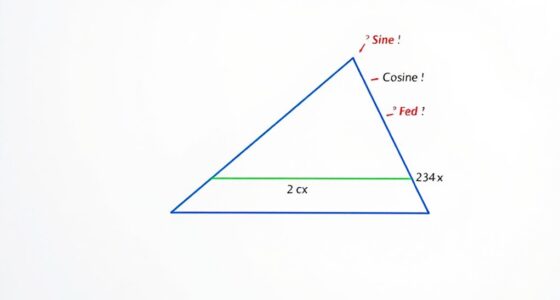Right triangle trigonometry helps you solve real-world problems by connecting angles and side lengths. You can determine heights, distances, and angles in construction, navigation, astronomy, and physics. Using functions like sine, cosine, and tangent, you’ll find unknown measurements quickly and accurately. This knowledge allows you to analyze forces, design structures, or navigate with GPS. Keep exploring to learn how these principles apply across many fields and situations.
Key Takeaways
- Trigonometry uses ratios of side lengths in right triangles to solve real-world height, distance, and angle measurement problems.
- Applications include construction for measuring heights and land distances without direct measurement.
- Navigation and GPS rely on triangulation and angle measurements to determine positions accurately.
- Astronomy employs stellar parallax and solar angles, using right triangle principles to measure celestial distances.
- Force component analysis in physics utilizes sine and cosine to resolve forces, aiding in motion prediction and structural design.
Understanding the Core Trigonometric Functions

Understanding the core trigonometric functions is essential for solving problems involving right triangles. These functions—sine, cosine, and tangent—are based on ratios of side lengths. To visualize them more broadly, think of the unit circle, a circle with a radius of one. As you move around the circle, the sine and cosine functions produce a repeating pattern called a sine wave. This wave shows how the sine value changes with angles, making it easier to understand periodic phenomena. When you grasp these concepts, you’ll see how the functions extend beyond triangles to fields like physics and engineering. The unit circle helps you connect the angles to their sine and cosine values, simplifying calculations and deepening your understanding of trigonometry’s fundamental principles. Recognizing the connection between mathematical models and real-world applications can further enhance your problem-solving skills.
Calculating Heights and Distances in Construction

In construction, accurately calculating heights and distances is crucial for safety and precision. You use trigonometry to determine the height of a building or the distance between two points without direct measurement. This is essential in building design, ensuring structures are correctly sized and positioned. Survey mapping relies on right triangle principles to measure land features accurately, helping you create detailed site layouts. By measuring angles and a known distance, you can apply tangent functions to find unknown heights or distances. These calculations prevent errors in construction plans, saving time and resources. Whether you’re evaluating the height of a tower or the span of a new bridge, trigonometry provides the tools to achieve accurate, reliable measurements efficiently. Understanding right triangle trigonometry is fundamental for applying these calculations effectively in real-world scenarios.
Navigating With Trigonometry in Geography and Marine Travel

Have you ever wondered how sailors and navigators determine their position across vast oceans or how explorers chart unknown territories? Trigonometry plays a crucial role in marine travel and geography. Navigators use techniques like GPS triangulation, which relies on measuring angles between satellites and your vessel to pinpoint your location precisely. Map projection helps translate the curved surface of the Earth onto flat maps, making navigation easier. Here are some key concepts:
- Using angles from known points to find your position
- Applying trigonometry to calculate distances across water
- Correcting for Earth’s curvature with map projection
- Employing triangulation for accurate positioning
- Combining satellite data with traditional methods
Understanding these methods allows sailors to navigate safely and accurately across the globe using right triangle trigonometry principles.
Using Trigonometry to Determine Angles in Astronomy

You can use trigonometry to measure distances to stars and planets by analyzing angles observed from Earth. Solar elevation angles help determine the Sun’s position in the sky at different times, revealing Earth’s tilt and rotation. Lunar observation techniques rely on calculating angles to understand the Moon’s distance and movement across the sky. Additionally, understanding the contrast ratio of telescopes and projectors can improve the clarity of astronomical images.
Stellar Distance Measurement
Ever wondered how astronomers measure the vast distances to stars? They use stellar parallax, a technique involving celestial triangulation. By observing a star from two different points in Earth’s orbit, astronomers measure the tiny angle of shift against background stars. This angle, combined with Earth’s baseline, allows calculation of the star’s distance through trigonometry. Here’s how it works:
- Measure the star’s apparent position at different times
- Determine the parallax angle from the observations
- Use right triangle trigonometry to relate angle and distance
- Apply celestial triangulation principles
- Convert angular measurements into actual distances
- Understanding the limitations of stellar parallax helps refine cosmic distance measurements
This method is most effective for nearby stars, providing a fundamental way to gauge cosmic distances. Stellar parallax remains a key tool in understanding our universe’s scale, all thanks to simple trigonometry.
Solar Elevation Angles
How do astronomers determine the Sun’s position in the sky at different times of the day? They measure the solar elevation angle, which is the angle between the Sun and the horizon. This angle tells you how high the Sun is at any given moment, affecting sunlight angles and shadows. To visualize this, imagine a simple diagram:
| Sun’s Position | Sunlight Angle |
|---|---|
| Low on the horizon | Small solar elevation |
| Midday | Large solar elevation |
| Sunrise or sunset | Near zero degrees |
| Noon | Maximum solar elevation |
Lunar Observation Techniques
Astronomers use trigonometry to determine the Moon’s position in the sky by measuring specific angles between the Moon, the observer, and other celestial objects. This technique helps with lunar phase calculations and predicting moonrise timing. By measuring the angle between the Moon and a reference point, you can calculate its elevation and azimuth. This data allows you to:
- Estimate the current lunar phase based on the Moon’s position
- Predict the exact time of moonrise and moonset
- Track the Moon’s movement across the sky
- Improve accuracy in celestial navigation
- Understand how the Moon’s position affects tides and other phenomena
- Utilizing professional tools like sextants enhances the precision of your measurements and observational data.
Using simple tools like a protractor or sextant, you can apply basic trigonometry to gather precise observational data, enhancing your understanding of lunar motions and their impact on Earth.
Engineering Applications: Designing and Analyzing Structures

Right triangle trigonometry plays a crucial role in engineering when designing and analyzing structures. It helps you determine angles and lengths critical to guaranteeing stability and safety. In bridge design, you use trigonometry to calculate the proper slopes, load distributions, and support angles, making sure the structure can withstand weight and environmental forces. During earthquake analysis, you analyze the angles and forces acting on buildings and bridges to assess how they will respond under seismic stress. Trigonometry allows you to model these forces accurately, predicting potential points of failure or excessive movement. By applying right triangle functions, you ensure structures are both resilient and efficient, optimizing their design for safety and durability in real-world conditions. Additionally, understanding building hours and operational times ensures maintenance and inspections are scheduled effectively to uphold safety standards.
Trigonometry in Physics: Analyzing Forces and Motion

When analyzing forces and motion, you’ll use trigonometry to break forces into components, making complex problems easier to solve. Inclined planes are a common example, where angles determine how much of a force acts parallel or perpendicular to the surface. Understanding these concepts helps you predict how objects move and respond to different forces in physics. Additionally, knowledge of appliance maintenance plans can help ensure safety and efficiency when dealing with electrical devices in various settings.
Force Components Analysis
Understanding how to break a force into its components is essential for analyzing motion in physics. This process, known as component resolution, simplifies force analysis by dividing a single force into perpendicular parts, usually horizontal and vertical. Doing so helps you determine how each component influences motion along different axes. Vetted – ID Times provides resources for mastering these concepts through clear explanations and practical examples. In force components analysis, you should:
- Use trigonometry to find force components with sine and cosine functions
- Identify the angle between the force and the axis
- Calculate the horizontal component with (F_x = F cos theta)
- Find the vertical component with (F_y = F sin theta)
- Apply these components to understand object acceleration or equilibrium
Mastering this technique clarifies how forces act on objects, enabling precise motion predictions.
Inclined Plane Dynamics
Analyzing forces on an inclined plane requires applying trigonometry to resolve the weight and other forces into components parallel and perpendicular to the surface. You start by breaking down the gravitational force into components: one along the incline and one perpendicular to it. This helps determine the normal force, which is essential for friction analysis. The high score system in arcade games encourages players to optimize their strategies to beat previous records. If friction is present, you’ll calculate the frictional force using the coefficient of friction and the normal force. The net force along the incline influences the object’s acceleration. By understanding these force components, you can solve for the object’s motion, whether it’s sliding down or being pushed up the inclined plane. Trigonometry simplifies the process, making it easier to analyze the dynamics of objects on inclined surfaces.
Practical Techniques for Solving Real-World Problems With Trigonometry

Practical application of trigonometry involves using right triangle techniques to solve real-world problems efficiently. To do this, you often analyze angles of elevation and depression to determine heights or distances. For example, measuring the angle of elevation to a building’s top helps find its height. Similarly, evaluating the angle of depression from a helicopter to a ship can reveal distance over water. Recognizing that prophetic dreams often contain symbols and messages can also aid in interpreting complex visual data.
Key techniques include:
- Applying sine, cosine, or tangent ratios based on known angles and sides
- Setting up right triangles from visual data
- Using inverse trigonometric functions to find angles
- Converting between angles of elevation/depression and distances
- Ensuring correct orientation and reference points for accurate calculations
These methods streamline problem-solving in fields like navigation, engineering, and surveying.
Frequently Asked Questions
How Do I Choose the Right Trigonometric Function for a Problem?
When you’re trying to choose the right trigonometric function, focus on the given information and what you need to find. Identify the angle involved, as it guides your angle selection. Use the appropriate trigonometric ratios—sine, cosine, or tangent—based on the known sides and what you’re solving for. Remember, sine relates opposite/hypotenuse, cosine is adjacent/hypotenuse, and tangent is opposite/adjacent, helping you select the correct function efficiently.
Can Trigonometry Be Applied to Non-Right Triangles?
You might think trigonometry only works with right triangles, but it definitely applies to oblique triangles too. In non-right applications, you use laws like the Law of Sines and Law of Cosines to solve for missing sides and angles. Don’t let the fear of complex formulas hold you back—these tools expand your problem-solving skills and uncover solutions in many real-world situations involving non-right triangles.
What Are Common Mistakes to Avoid in Trigonometric Calculations?
When doing trigonometric calculations, avoid common mistakes like forgetting to convert angle units, especially between degrees and radians. Always double-check your unit conversion before applying sine, cosine, or tangent functions. Also, make sure you’re using the correct angle measurement for your problem. Mistakes often happen if you mix units or assume the wrong angle type, leading to inaccurate results. Paying attention to these details keeps your calculations precise.
How Does Angle Measurement Affect Trigonometric Problem-Solving?
When solving trigonometric problems, you need to understand how angle measurement affects your results. Using the correct angle units—degrees or radians—is essential for measurement accuracy. If you switch between units without adjusting your calculations, you’ll get incorrect answers. Always double-check your angle units before solving, and make certain your calculator is set properly. Accurate angle measurement helps you find precise sine, cosine, and tangent values, improving overall problem-solving reliability.
Are There Software Tools to Assist With Complex Trigonometric Problems?
Imagine tackling a monstrous, mind-boggling trigonometric problem without breaking a sweat—that’s where software tools shine! You can use advanced graphing calculators and software simulations to visualize functions, find angles, and solve complex problems effortlessly. These tools turn what seems impossible into child’s play, saving you time and frustration. With their help, you gain clarity and confidence, making even the most intimidating trigonometric challenges manageable and approachable.
Conclusion
By mastering right triangle trigonometry, you open a toolkit that turns complex problems into clear solutions. Like a lighthouse guiding ships through fog, these skills illuminate real-world challenges—from construction to navigation, astronomy to physics. With practice, you’ll navigate the world’s angles and distances effortlessly, transforming abstract formulas into tangible insights. Embrace these techniques, and you’ll find yourself wielding math as a compass, guiding you safely through life’s intricate maze.









